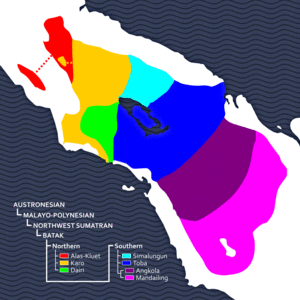| Batak | |
|---|---|
| Toba–Batak | |
| Geographic distribution | Sumatra, Indonesia |
| Linguistic classification | Austronesian
|
| Subdivisions |
|
| ISO 639-2 / 5 | btk |
| Glottolog | toba1265 |
 The distribution of Batak languages in northern Sumatra | |
The Batak languages are a subgroup of the Austronesian languages spoken by the Batak people in the Indonesian province of North Sumatra and surrounding areas.
Internal classification
The Batak languages can be divided into two main branches, Northern Batak and Southern Batak. Simalungun was long considered an intermediary, but in current classifications it is recognized as part of the Southern branch.[1][2] Within Northern Batak, a study noted 76% cognate words between Karo and Alas, 81% with Pakpak, 80% with Simalungun, and 30% with Malay (Indonesian).[3] Karo and Toba Batak are mutually unintelligible.
| Batak languages |
| |||||||||||||||||||||||||||||||||
Mandailing and Angkola are closer related to each other than to Toba. The geographical influences on the Batak languages can be seen in the map in the infobox; Lake Toba separates the Karo from direct contact with the Toba.
Reconstruction
| Proto-Batak | |
|---|---|
| Reconstruction of | Batak languages |
Reconstructed ancestors | Proto-Austronesian
|
The Batak languages can be shown to descend from a hypothetical common ancestor, Proto-Batak (which in turn originates from Proto-Austronesian). The sound system of Proto-Batak was reconstructed by Adelaar (1981).[2]
| Labial | Alveolar | Palatal | Velar | Glottal | ||
|---|---|---|---|---|---|---|
| Stop | voiceless | *p | *t | *c | *k | |
| voiced | *b | *d | *j | *ɡ | ||
| Fricative | *s | *h | ||||
| Nasal | *m | *n | *ŋ | |||
| Semivowel | *w | *y | ||||
| Lateral | *l | |||||
| Trill | *r | |||||
| Front | Central | Back | |
|---|---|---|---|
| High | *i | *u | |
| Mid | *ə | ||
| Low | *a |
Final diphthongs: *-uy, *-ey, *-ow.
The Proto-Batak sounds underwent the following changes in the individual daughter languages:[2]
- Proto-Batak *k became h in initial and medial position in the Southern Batak languages:
- Proto-Batak *kalak > Toba, Simalungun halak; Karo kalak 'person'
- Proto-Batak *dukut > Toba, Simalungun duhut; Karo dukut 'grass'
- Proto-Batak *h was lost in Toba, Angkola and Mandailing:
- Proto-Batak *pərəh > Toba poro, Simalungun poroh, Karo pereh /pərəh/ 'wring out'
- Proto-Batak final voiced stops *b, *d, and *g are retained only in Simalungun. In Toba, Angkola and Mandailing, they are unvoiced, while in the Northern Batak languages, they changed to homorganic nasals (/m/, /n/, /ŋ/):
- Proto-Batak *dələg > Simalungun dolog, Toba dolok, Karo deleng /dələŋ/ 'mountain'.
- The central vowel *ə is retained in the Northern languages, and shifted to /o/ in the Southern languages:
- Proto-Batak *ənəm > Karo enem (/ənəm/), Toba onom 'six'
- Proto-Batak diphthongs are only retained in Simalungun, but shifted to monophthongs in all other Batak languages:
- Proto-Batak *apuy > Simalungun apuy; all other languages api 'fire'
- Proto-Batak *matey > Simalungun matei; all other languages mate 'dead'
- Proto-Batak *pulow > Simalungun pulou; all other languages pulo 'island'
Writing system
Historically, the Batak languages were written using the Batak script, but the Latin script is now used for most writing.
References
- ^ Comparative Austronesian dictionary Vol. 1. by Darrell T. Tryon, Shigeru Tsuchida et al. p421 et seq
- ^ a b c Adelaar, K. A. (1981). "Reconstruction of Proto-Batak Phonology". In Robert A. Blust (ed.), Historical Linguistics in Indonesia: Part I, 1-20. Jakarta: Universitas Katolik Indonesia Atma Jaya.
- ^ The Austronesian languages of Asia and Madagascar. K. Alexander Adelaar, Nikolaus Himmelmann, p. 535
External links
- http://unicode-table.com/en/sections/batak/
- Batak languages at Ethnologue (22nd ed., 2019).